When working on any construction job, the right safety equipment is paramount to ensuring that your work ends with nobody getting hurt. Finding out what equipment you need to wear is one of the most important parts of working in new and varied industries. If you ever find yourself working with high amounts of electrical hazards, you might’ve already come across and even worn an electrical hard hat.
Hard hats come in several different classifications. Fittingly, electrical hard hats are Class E. This type of hard hat was specifically designed to protect wearers from high voltages of electricity – sometimes even up to 10,000 volts of the lightning-bolt stuff at a time!

The unfortunate downside of electrical hard hats is that their protection doesn’t extend to the rest of the wearer’s body – it only protects the head from electrical shock. So, if you were planning to wait out a thunderstorm with the right electrical hard hat, we wouldn’t recommend it.
Considerations When Shopping for an Electrical Hard Hat
There are plenty of things to remember when shopping for an electrical hard hat of your own, including the hat’s fit, comfortability factor, electrical protection rating, accessory compatibility, and overall quality. You won’t want to settle for an electrical hard hat with a low electrical protection rating, so give yourself a decent budget when picking out a hat. After all, your safety is on the line.
Electrical Protection Rating
Generally speaking, most workers seeking out an electrical hard hat will want to go with one that is rated to protect against voltages of up to 20,000 volts, as many construction sites have live wires, exposed wiring, and other electricity sources that could easily harm someone if exposed to their unprotected head.
Hard hats rated to protect against this level of electric shock are classified as class E hard hats. However, the lesser-known hard hat class G is another kind of electrical hard hat – they protect against up to 2,200 volts, which is still quite a lot of electricity.
Here is the Amazon Link to the Uninova Electrical Hard Hat – (Paid Link) that we use when out in the field that offers the most reliable protection. These are Electrical Class E, ANSI Z89.1 Approved OSHA Hard Hats available in a variety of colors.
Accessory Compatibility
You can hook up some hard hats with a few accessories that make life on the job easier. These include earplugs and over-the-ear earmuffs to drown out loud power tools and other equipment.
Another piece of personal protective equipment you should wear is a safety Google or visor to protect your face from potential sparks. A headlamp is another accessory you might want to latch onto your electrical hard hat. If accessorizing easily is essential, make sure you end up with an option that suits your needs.
Comfort & Fit
Once you’ve put on your electrical hard hat and gone to work, you don’t always just get to take things off when they get uncomfortable. When you’re in a rough situation on the job, the last thing you will want to have on your mind is just how uncomfortable your electrical hard hat is.
Invest in an option that isn’t just bearable but actively comfortable. You aren’t going to want to have to take your protective gear off over and over again. Plus, if your boss is a stickler, they might not let you do so.

Best Practices for Wearing and Maintaining an Electrical Hard Hat
Now, we know what you’re thinking. Hard hats have been around for decades – who doesn’t know how to wear and maintain their hard hats properly? To answer your question, our school of thought has always been to be safe rather than sorry.
To properly wear your electrical hard hat, you will want to ensure it fully covers your head. Make sure it snugly fits and doesn’t wobble or wiggle when you make sudden movements. If there is a chin strap that allows you to lock it into place around your head securely, we encourage you to use it.
When working on a site with high amounts of electricity, there is quite a risk of damage or injury. Avoid such risks by properly wearing your electrical hard hat.
Regarding maintenance, hard hats of just about any kind are durable. You won’t want to expose them to corrosive substances or high degrees of trauma, but they can handle most day-to-day wear without you having to worry too much.
As long as you aren’t hitting your hard hat with a hammer every morning, you’ll probably be in the clear. Most hard hats can last for decades if properly maintained. However, you should remember that if your electrical hard hat has suffered excessive denting or cracks, you should get it replaced. And what’s more, according to OSHA, your employer is obligated to replace it.

Keeping This All In Mind
If you’re about to embark on a new job that requires you to wear an electrical hard hat, then we wish you all the best. We hope this article sheds new light on a subject you might not have known much about.
Not many construction workers know that specific hard hats can provide head protection from electrical hazards, and even fewer people know what to look for when shopping for them. That’s why we do our best to spread as much information as possible about these subjects. We hope we were able to help today!
Related Resources:
